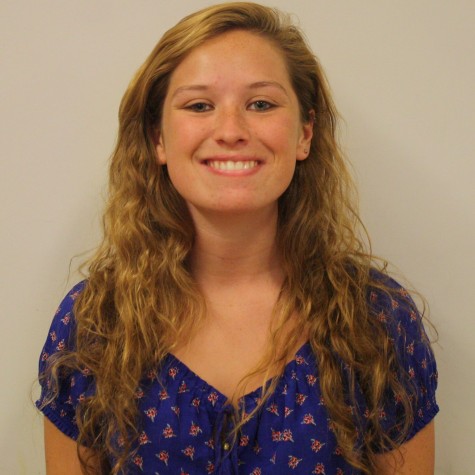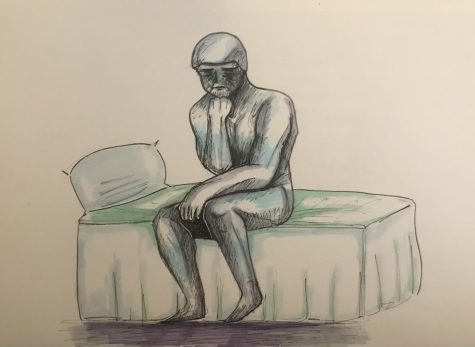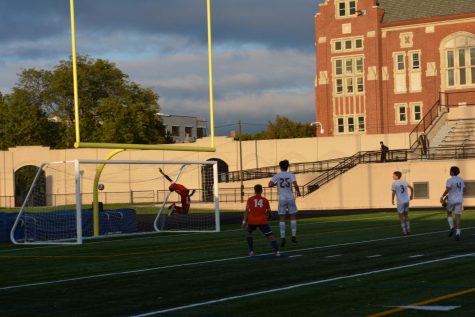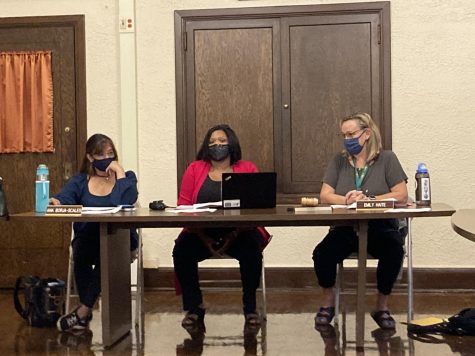Soccer players cope with concussions

The Girl’s Varsity Soccer Team reclaimed the city championship from rival Whitney Young on May 14. With a 19-5 overall record (13-0 in conference) this season, the team saw their season end May 22 with a double overtime regional final loss to Maine South. Pictured: Senior soccer players Caitlin Acevedo, left, Sofia Pavon, Anastasia Niforos, and Maeve McMahon
June 3, 2015
There were only 10 minutes remaining in the
game when senior defender Caitlin Acevedo went
up for a header against a Downers Grove South
soccer player.
The contact did not immediately draw the attention of players or coaching staff, whose focus
shifted to another part of the field to follow the
action of play, according to Varsity Head Coach
Michelle Vale-Suarez.
Though Acevedo stayed on her feet after the hit,
she had suffered a head injury.
“I stumbled to the sidelines, over to my team
and coach,” Acevedo, Div. 569, said.
After her injury, Acevedo felt disoriented and
dizzy. Although Acevedo is a veteran player – having been on the Varsity Girls Soccer Team for
three years – she said she was terrified.
“It was my second concussion, but this one was
worse. I was so scared.”
The fear stems from the most dangerous possible
result of a concussion – brain injury, which can
be either immediate or gradual and can range in
severity. Because of this, any visible symptoms are
approached with extreme caution.
Lane’s athletic trainer, Albert Buzun, said that
any athlete who experiences a head injury and
shows any signs or symptoms of a concussion
must be removed from play, and cannot return
the same day.
“They must be evaluated by a trained medical staff member before returning to play,” Buzun
said.
Some symptoms can develop or worsen in the
aftermath of a head injury.
“The trainer told my mom that if my eyes ever
dilated, or I started to vomit and I started to lose
consciousness again, I needed to go to the hospital,” Acevedo said.
During their child’s concussion, the Acevedos
were brutally aware of any changes in physical
behavior, and Caitlin’s own life was under close
scrutiny in the weeks following her injury. She
was prohibited from driving, texting, watching
TV, and being exposed to sunlight for long periods of time.
Promising to attend intensive physical therapy
for six weeks and stay away from headers, Acevedo
rejoined her team on April 18, playing against Oswego East, and just missing the cut to play in the
game against long-time rival Whitney Young.
Acevedo is not the only player on the team with
a prior concussion who suffered a second one this
season. Senior forward Natalie Wade, Div. 565,
received her first concussion when she was hit in
the head with a softball her freshman year.
Wade’s concussion this year resulted from a collision with an opposing goalkeeper.
“I was out for about 3-4 weeks [this season], but
my recovery was much faster than my first concussion. I was scared because I wanted to be able
to play, and also because of the lasting effects. I
was even considering getting an MRI just because
of how bad my first concussion was,” Wade said.
After the collision with the goalie, the referee
stopped the game, and Buzun examined her. Later, she felt an intense, pounding headache. After
going through memory and balance tests, Wade
said, her injury was obvious.
“Athletes have to realize that every concussion
is different. Their symptoms and recovery may
be different from their teammates who sustained
either a more severe or milder concussion than
them. The key to concussion recovery is plenty
of rest – that is, physical and mental rest,” Buzun
said.
In the past few years, concussions have become
more commonly detected and properly treated.
“There’s definitely more of a cautious feel. Every-
one immediately starts thinking about the player’s
well-being when they go up for a header or their
head hits the ground,” Vale-Suarez said.
This past November, a class-action concussion
lawsuit was filed by a former high school foot-
ball player against the IHSA, claiming that more
precautions need to be taken against preventing
concussions. The lawsuit’s intent is to grant court
supervision over the management of head injuries
in high school sports.
According to the Chicago Tribune, the IHSA
said in a statement that “coaches and doctors – not
lawyers- should manage high school sports.” They
believe that the lawsuit could add additional, un-
necessary expenses to playing high-contact sports, like soccer and football, that some students may not be able to afford.
All other high schools aside, Margarita Mercardo, Div. 581, feels comfortable with the way
concussions are handled here. They are not an in-
jury taken lightly.
“I do feel that proper measures are taken, and
especially with our trainer Albert. He is really
cautious when it comes to concussions,” Mercado
said.
Mercado is the third senior on the team who
suffered a concussion this season. Early in the first
half of a game during the annual Pepsi Showdown
tournament, Mercado was struck with two blows
to the head; first the ball, second, her competitor’s head.
“The first thing I felt was a headache that didn’t
go away for days. I did not know it was a concussion until three days later. I had the urge to cry
for no reason and I felt really depressed. I couldn’t
focus or sleep,” Mercado said.
Only halfway through the season, three senior
girls on the varsity squad had been sidelined with
symptoms of concussions. “It follows the same trend as last year.
Girls soccer has the second-highest incident rate for con-
cussions right behind boys football. This year we
were very lucky that all athletes who did sustain
a concussion recovered quite quickly with no set-
backs,” Buzun said.
In the past few years, concussions have been
monitored much more closely and recognized
more often, Buzun said. Buzun recalls how he
has seen more protective measures being taken in
his years as a trainer. Among these is the “RTP,”
which is a 7-day program that eases an athlete
into both full play and full contact.
“Each day of the protocol the athlete is perform-
ing tasks that involve cardio, balance, memory,
cognitive thinking, and eye (ocular) exercises,”
Buzun said.
In addition, coaches and officials receive mandatory concussion training prior to each season,
and student-athletes and their families also receive
information about recognizing symptoms.
“I think that we are much more aware of the
issues concussions can lead to in the future, and
worried about the negative impacts they can have
on us – not only as a student, but as a person,”
Wade said.






